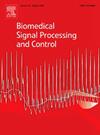A new methodological approach based on stationarity and permutation entropy of EMG Bursts for assessing muscle function alterations in a Parkinson’s disease animal model
IF 4.9
2区 医学
Q1 ENGINEERING, BIOMEDICAL
引用次数: 0
Abstract
The EMG signal is the electrical manifestation of motor unit recruitment processes underlying the contractile dynamics of muscle fibers. The analysis methodology frequently carried out includes a preprocessing stage based on artifact removal, stationarity testing, a feature extraction and interpretation stage. Generally, stationarity criteria are difficult to meet when EMG signals are evoked by momentary activations (bursting activity). Thus, the study of contractile patterns evoked in free-moving protocols require particular treatments. Here, we propose a new approach for quantitatively measuring stationarity by using mean, variance and autocovariance test (MVA-test) and the Permutation Entropy for measuring uncertainty degree. This methodology was applied to EMG signals obtained from a Parkinson’s disease (PD) lesion model to longitudinally study the muscle function alterations. The MVA-test revealed that the temporal structure of EMG around the reference contractile zone presents incremental non-stationary characteristics over post-injury time. Likewise, it was observed that the initial phase of motor recruitment in the biceps femoris (BF) muscle (around the onset) presents a high non-stationary component, which increases over post-injury time. Permutation entropy measures throughout the contractile dynamics of the BF muscle revealed that the uncertainty degree decreases in the initial phase of contraction as the animal’s post-injury time increases. The analysis proposed allowed for a longitudinal characterization of muscle function alterations in an animal model of PD in terms of the stationarity properties of EMG signals. Furthermore, it was observed that permutation entropy could serve as a robust biomarker for quantifying neuromuscular remodeling caused by PD progression.
求助全文
约1分钟内获得全文
求助全文
来源期刊

Biomedical Signal Processing and Control
工程技术-工程:生物医学
CiteScore
9.80
自引率
13.70%
发文量
822
审稿时长
4 months
期刊介绍:
Biomedical Signal Processing and Control aims to provide a cross-disciplinary international forum for the interchange of information on research in the measurement and analysis of signals and images in clinical medicine and the biological sciences. Emphasis is placed on contributions dealing with the practical, applications-led research on the use of methods and devices in clinical diagnosis, patient monitoring and management.
Biomedical Signal Processing and Control reflects the main areas in which these methods are being used and developed at the interface of both engineering and clinical science. The scope of the journal is defined to include relevant review papers, technical notes, short communications and letters. Tutorial papers and special issues will also be published.
 求助内容:
求助内容: 应助结果提醒方式:
应助结果提醒方式:


